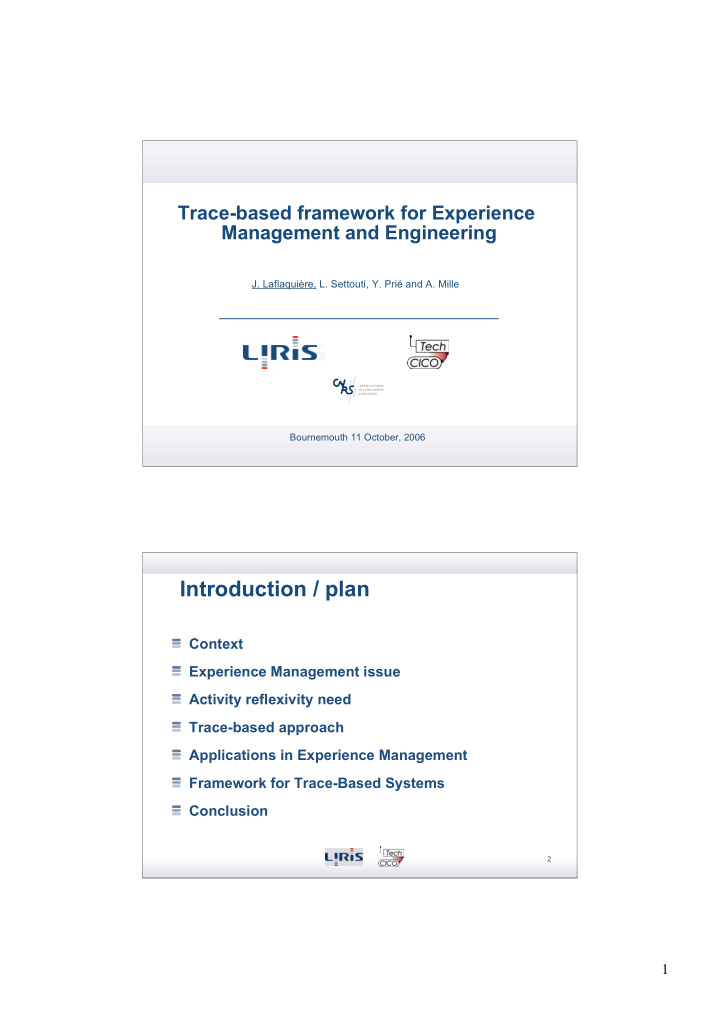



Trace-based framework for Experience Management and Engineering J. Laflaquière, L. Settouti, Y. Prié and A. Mille Bournemouth 11 October, 2006 Introduction / plan Context Experience Management issue Activity reflexivity need Trace-based approach Applications in Experience Management Framework for Trace-Based Systems Conclusion 2 1
Context Experience Management challenge Tacit knowledge in work situations Identify, capitalize and reuse experience Particularly the case in mediated work situations and high-level abstraction tasks Focus on Digital Documentary Spaces Complex Tasks Example: Economic Intelligence on the Web 3 Context Digital Documentary Spaces A digital environment including a large sets of digital documents and the tools to manipulate them. Web sources, Databases, Web pages, Blogs … Search and collect tools, communication tools … Complex tasks features High level – domain and web knowledge Dynamic – evolutive process Open-ended – unstable goal Context dependent – depending on current situation 4 2
Experience Management issue Complex mediated tasks These tasks generate rich interactions which hold on the experience of environment use. A few information about these interactions remain available in a digital space. Only the results of the activity are presents to users. It’s difficult to capture this experience because: Experience and knowledge are built dynamically through interactions with a system. Users are not automatically conscious of their experience. Need of “activity reflexivity” 5 Experience Management issue 6 3
Reflexivity need Reflexivity in task realization Difficult to identify and remember experiences, and then to capitalize it, share it, and reuse it. We can define activity reflexivity as the access to a representation of our own activity. Numerous works have shown the benefits of activity reflexivity, particularly in mediated environment. Activity structuration What methods to provide reflexivity to users ? Quantitative vs qualitative approaches Trace-based approach 7 Reflexivity need Quantitative approach: Log-files To record raw machine events and find some statistics regularities and try to provide indicators to the user. How to use global indicators in a particular task realization ? 8 4
Reflexivity need Qualitative approach : Observation Observation performed by expert analyst. Important results with fine grain analysis but expensive and not continuous. How to gain from analysis results ? 9 Trace based approach Trace based approach We need a use trace which make sense in the involved task. We need it at a suitable abstraction level. The point is to create a model which defines interaction elements constituting the trace. The trace must be built during interaction by using this model. 10 5
Trace based approach 11 Trace based approach Important points We propose a use trace with a suitable abstraction level to make sense for the system and for the user in his task. This trace is used to provide reflexivity in this task, and to allow the user being conscious of his proper experience. This provided support can be a first step in a Experience Management process. What applications of trace based system can be proposed in Experience Management context ? 12 6
Applications Reflexivity and contextualization Each component is contextualized by the others in the trace. Example in a DDS: the trace can provide an access to the documents through their use. 13 Applications Sharing experience The use trace is not the experience or a part of it. The trace is a support to deal with the experience of use, and firstly a mnesic support. Support for sharing experience situations: memory project, formation, knowledge map … 14 7
Applications Reusing experience Significant episodes identified. Query trace base and compare to the current task. The trace is not the solution, but a support in the task realization. 15 Framework Generic Framework Various applications of Trace Based Systems (TBS). Need of a global framework. Several systems have been identified, and can be used independently. Management system Collecting system Transformation system Framework Query system Visualization system 16 8
TBS Framework Collecting system Conversion of several tracing sources into a basic trace. Transformation system Modify the trace by enriching or filtering by using a transformation model. Modify the model of trace or update trace base. Visualization system Techniques to display traces in a visual form allowing human’s direct exploitation. Query system To allow trace base exploitation Management system To manage various models involved 17 Conclusion Outcome Complex tasks in DDS as a Experience Management issue. Reflexivity question and use trace proposition. Applications of a Trace Based System examples. Presentation of a global framework for Trace Based Systems. Future work Framework instantiations into various real Trace Based Systems Several domains remain to be explored. Visualization tools To represent thick information in a narrow space. To provide a support for reflexivity and interactivity with the trace. 18 9
Thank you for your attention 10
Recommend
More recommend